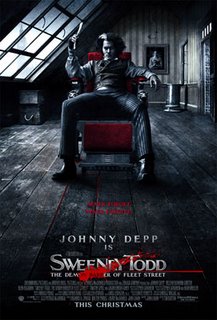
I have watched many local and professional productions of Stephen Sondheim's musical,
Sweeney Todd: The Demon Barber of Fleet Street. The one thing that has always amazed me about the show is what a difficult line of balance there must be in order for the show to work. The story is a dark and ultimately tragic story of revenge, but there is also a wicked sense of humor throughout. The humor is quite vicious, and we sometimes find ourselves laughing at ourselves for laughing at the terrible things the characters talk about, or do to each other. It doesn't always leave its audience feeling comfortable, but when it works, it is an unforgettable piece of theater.
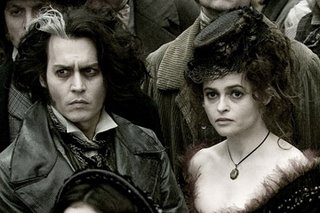
The movie adaptation by filmmaker Tim Burton (
The Corpse Bride) did not entirely work for me due to one essential reason. It places too much emphasis on the torture and pain of the story, and not enough on the devilish humor. As I was watching the movie, I kept on asking myself why the story and the characters weren't clicking the way they usually do when I watch the show. It was a question that bothered me even on my way home. The more I thought about it, the more I came to realize that this is a mostly joyless production. All the gothic melodrama, the murder, and the violence of the story have been left in place. If anything, the violence has been increased to such a point that the film's R-rating should definitely be taken into consideration for any parent who has a teen that wants to see this film. What the movie lacks is that sense of false hope, false light, and the wicked sense of humor. Burton's interpretation takes itself way too seriously and focuses so much on the dark that it forgets to have fun with itself from time to time. Though this is a mainly faithful adaptation (only a few songs have been removed, shortened, or switched in order), the tone of the movie is all wrong.
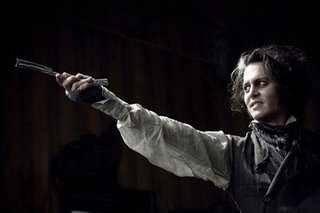
Set in 19th Century London, a man named Benjamin Barker (Johnny Depp) has escaped from a prison he was sentenced to 15 years ago for a crime he didn't commit, and has now returned home using the alias Sweeney Todd. During his time away, he's thought of nothing but seeking revenge on the corrupt Judge Turpin (Alan Rickman), who ruined his life in the first place, and being reunited with the wife and young daughter who were left behind. He heads straight for his home, only to be informed by the woman who runs the pie shop below his old barber shop, Mrs. Lovett (Helena Bonham Carter), that his beloved wife took her own life after the Judge raped her, and that his daughter, Johanna (Jayne Wisener), is now Turpin's adopted ward. Fueled even more by revenge, Barker/Todd decides to go back into the barber business, only under more sinister intentions. His plan is to build a name for himself so that he can eventually lure the Judge into his shop, and slit his throat while the man who destroyed his life sits in his barber chair. The ever-resourceful Mrs. Lovett sees further business opportunities in the plan, realizing that his victims could make good fillings for the meat pies she sells. As their twisted business partnership grows in popularity and the victims pile up, it can only be a matter of time before the characters learn that "the path to revenge can lead to hell", as the show's closing number (which is not included in the film) states.
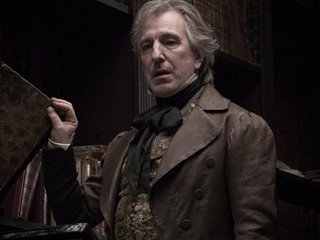
I will definitely say this for Burton's take on
Sweeney Todd, this is the most beautiful (in a gothic sort of way) interpretation of the story I have seen. The movie uses a mostly muted color scheme to the point that some of the characters almost seem to be in black and white. Indeed, one of the most visually stunning sequences of the film is when we see Todd and Lovett sitting together in the middle of a sun-filled park, but the small space around them remains dark and overcast, almost like those old cartoons where a character would have a rain cloud constantly hovering over their heads. This film is certainly not cartoonish in its overall look, however. It is a menacing, gritty, and probably realistic interpretation of old time London. Rats and sewage scurry and flow on the streets. The tall, almost menacing, buildings are built too close together and seem to reach so high that they could block out the sun, if the weather in Sweeney's world wasn't constantly overcast except for a few brief instances. The overall visual design by cinematographer Dariusz Wolski (
Pirates of the Caribbean: At World's End) is dark and claustrophobic, but in an artful way. This is part of the reason why the film's often graphic depictions of Sweeney's murders are so striking. The blood that literally sprays forth from his victims' necks (sometimes covering any actor unfortunate enough to be standing too close head-to-foot) seems almost out of place with the movie's drab color scheme. Of course, this is intentional, and it makes the sequences more effective and stand out more. Even the opening credit sequence is beautiful, as we follow a trail of blood through places and machines that we will become very familiar with during the course of the film. I almost feel like recommending the movie for its visual style, and I hope it's recognized come award time.
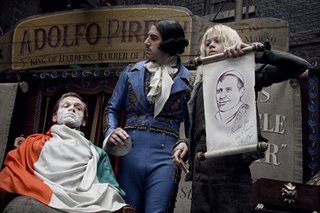
As anyone who has ever performed musical theater can tell you, the musical scores of composer Stephen Sondheim are some of the best around, yet also some of the most complex as well.
Sweeney Todd definitely lives up to this reputation, as it has long been one of my favorite scores from the theater world. Almost all of the songs are represented in the film, though there are a few glaring omissions, particularly the show's main theme, "The Ballad of Sweeney Todd". The song is present in an instrumental version played various times throughout the film (most memorably the opening credits), but it's such a perfect way to set up the story and get you involved, it's almost a crime the lyrical version wasn't included in the final film. Most of the songs that were included are heard in their entirety, although some major numbers such as "God, That's Good" (sung by the customers sampling Lovett's meat pies, not knowing what they're made of) have been shortened and taken out of their proper sequence. Nonetheless, the important question is how well are they sung? The fact that the film's main cast does not include one star especially known for their musical talents is something that has worried many fans of the original show, myself included, during the past year. Fortunately, there is little reason for anyone to worry. Johnny Depp portrays a very different take on Sweeney Todd than most fans are used to. He's somewhat quieter and sometimes more subtle in his growing madness, but he is no less intense than any performance I have seen on the stage. I do have a harder time accepting Helena Bonham Carter as Mrs. Lovett, however. She's often comes across as being far too quiet, somewhat mousey, and even timid to successfully pull off the character. Her voice is also often quite soft, sometimes being drowned out by the orchestra accompanying her off screen. It's not a bad performance actually, she simply lacks the power and confidence the character needs.
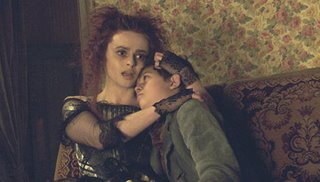
If that were my only complaint, I could easily let it go, but I fear that there is a much larger problem lurking at the core of this movie that prevents me from giving it a full-hearted recommendation. There were a lot of decisions I did not agree with watching the film, the biggest being I did not agree with the way the show's deliciously devilish sense of humor has been muted to the point that it's either not as funny as it usually is, or it's just not there at all. A very good example is the musical number "A Little Priest". This is the number that closes the first half of the play and film, and it is a darkly comic one as Todd and Lovett devise their twisted business partnership, and crack each other up by making sick jokes about the kind of pies she will sell, and who they will be made from. The way the film interprets it, there is absolutely no evil glee. They don't seem excited by the possibilities as they describe their plans to each other, nor do I remember them even cracking a smile. This is supposed to be a grand, rousing number that gets you excited about the evil possibilities in store for the rest of the story, but the movie plays it so muted and almost mopey, I couldn't get excited like I always do when I hear the song properly performed. This is not the only way the film has changed, and not for the better. There is a Beggar Woman who pops up throughout the story, and ultimately plays a very large role, though we do not learn what until almost the end. In the film, Todd has very little interaction or encounters with this woman, which really hurts the revelation her character plays. Almost all of Todd's encounters with the woman have been cut from the film, which is a big mistake, since it was his often cruel treatment toward her that made the final reveal all the more tragic. This aspect is still there in some sense, but it didn't hit quite as hard as it usually does.
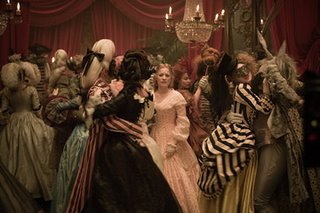
I understand some things in a musical need to be cut in order to fit the preferred two hour time limit of Hollywood, but some of these cuts wound up greatly disappointing me, particularly at the end. The film's ending is highly anticlimactic and seems to simply just stop instead of coming to a proper end. The show's final dialogue and closing number have been removed, and because of this, the movie ends with a bloody whisper instead of a bloody bang like it should. That could kind of describe my feeling of the film's entirety. Although it is beautifully filmed, well-performed for the most part, and remains mostly faithful to the source material, there is a sense of grandness missing from the overall production. Everything except the violence seems more quiet, more subtle than it should be. I have seen some performances of
Sweeney Todd on the stage that were small in scope and scale. Heck, I even saw one production last year in New York that had no orchestra, where the actors played the instruments when they were not singing. They made up for the lack of scale and scope with their powerful voices, and with the devilish glint of evil glee they tackled the story with. There's very little glee found here, and the moments of power are scarcer than usual.
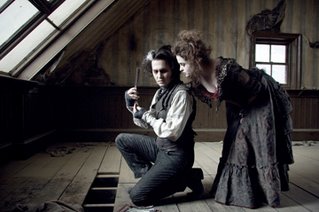
While I cannot give this take of
Sweeney Todd a full endorsement, I do have to say that what it does, it does very well. Those who are not familiar with the original musical are bound to enjoy it, provided they can stomach some over the top gore. And besides, any movie that can introduce more people to the works of Sondheim deserves at least some sort of praise from me. That being said, the movie just didn't fill me with the usual emotions that I feel. If you find yourself liking this film, I highly recommend you track down one of the many CD recordings of the original production, or even the DVD of a live performance from a national touring company that was running in the early 80s. I'm on the fence with this one, I'm afraid. There are a lot of good ideas here fighting for space with ideas that don't work the way they should.
0 comments
 I have watched many local and professional productions of Stephen Sondheim's musical, Sweeney Todd: The Demon Barber of Fleet Street. The one thing that has always amazed me about the show is what a difficult line of balance there must be in order for the show to work. The story is a dark and ultimately tragic story of revenge, but there is also a wicked sense of humor throughout. The humor is quite vicious, and we sometimes find ourselves laughing at ourselves for laughing at the terrible things the characters talk about, or do to each other. It doesn't always leave its audience feeling comfortable, but when it works, it is an unforgettable piece of theater.
I have watched many local and professional productions of Stephen Sondheim's musical, Sweeney Todd: The Demon Barber of Fleet Street. The one thing that has always amazed me about the show is what a difficult line of balance there must be in order for the show to work. The story is a dark and ultimately tragic story of revenge, but there is also a wicked sense of humor throughout. The humor is quite vicious, and we sometimes find ourselves laughing at ourselves for laughing at the terrible things the characters talk about, or do to each other. It doesn't always leave its audience feeling comfortable, but when it works, it is an unforgettable piece of theater. The movie adaptation by filmmaker Tim Burton (The Corpse Bride) did not entirely work for me due to one essential reason. It places too much emphasis on the torture and pain of the story, and not enough on the devilish humor. As I was watching the movie, I kept on asking myself why the story and the characters weren't clicking the way they usually do when I watch the show. It was a question that bothered me even on my way home. The more I thought about it, the more I came to realize that this is a mostly joyless production. All the gothic melodrama, the murder, and the violence of the story have been left in place. If anything, the violence has been increased to such a point that the film's R-rating should definitely be taken into consideration for any parent who has a teen that wants to see this film. What the movie lacks is that sense of false hope, false light, and the wicked sense of humor. Burton's interpretation takes itself way too seriously and focuses so much on the dark that it forgets to have fun with itself from time to time. Though this is a mainly faithful adaptation (only a few songs have been removed, shortened, or switched in order), the tone of the movie is all wrong.
The movie adaptation by filmmaker Tim Burton (The Corpse Bride) did not entirely work for me due to one essential reason. It places too much emphasis on the torture and pain of the story, and not enough on the devilish humor. As I was watching the movie, I kept on asking myself why the story and the characters weren't clicking the way they usually do when I watch the show. It was a question that bothered me even on my way home. The more I thought about it, the more I came to realize that this is a mostly joyless production. All the gothic melodrama, the murder, and the violence of the story have been left in place. If anything, the violence has been increased to such a point that the film's R-rating should definitely be taken into consideration for any parent who has a teen that wants to see this film. What the movie lacks is that sense of false hope, false light, and the wicked sense of humor. Burton's interpretation takes itself way too seriously and focuses so much on the dark that it forgets to have fun with itself from time to time. Though this is a mainly faithful adaptation (only a few songs have been removed, shortened, or switched in order), the tone of the movie is all wrong. Set in 19th Century London, a man named Benjamin Barker (Johnny Depp) has escaped from a prison he was sentenced to 15 years ago for a crime he didn't commit, and has now returned home using the alias Sweeney Todd. During his time away, he's thought of nothing but seeking revenge on the corrupt Judge Turpin (Alan Rickman), who ruined his life in the first place, and being reunited with the wife and young daughter who were left behind. He heads straight for his home, only to be informed by the woman who runs the pie shop below his old barber shop, Mrs. Lovett (Helena Bonham Carter), that his beloved wife took her own life after the Judge raped her, and that his daughter, Johanna (Jayne Wisener), is now Turpin's adopted ward. Fueled even more by revenge, Barker/Todd decides to go back into the barber business, only under more sinister intentions. His plan is to build a name for himself so that he can eventually lure the Judge into his shop, and slit his throat while the man who destroyed his life sits in his barber chair. The ever-resourceful Mrs. Lovett sees further business opportunities in the plan, realizing that his victims could make good fillings for the meat pies she sells. As their twisted business partnership grows in popularity and the victims pile up, it can only be a matter of time before the characters learn that "the path to revenge can lead to hell", as the show's closing number (which is not included in the film) states.
Set in 19th Century London, a man named Benjamin Barker (Johnny Depp) has escaped from a prison he was sentenced to 15 years ago for a crime he didn't commit, and has now returned home using the alias Sweeney Todd. During his time away, he's thought of nothing but seeking revenge on the corrupt Judge Turpin (Alan Rickman), who ruined his life in the first place, and being reunited with the wife and young daughter who were left behind. He heads straight for his home, only to be informed by the woman who runs the pie shop below his old barber shop, Mrs. Lovett (Helena Bonham Carter), that his beloved wife took her own life after the Judge raped her, and that his daughter, Johanna (Jayne Wisener), is now Turpin's adopted ward. Fueled even more by revenge, Barker/Todd decides to go back into the barber business, only under more sinister intentions. His plan is to build a name for himself so that he can eventually lure the Judge into his shop, and slit his throat while the man who destroyed his life sits in his barber chair. The ever-resourceful Mrs. Lovett sees further business opportunities in the plan, realizing that his victims could make good fillings for the meat pies she sells. As their twisted business partnership grows in popularity and the victims pile up, it can only be a matter of time before the characters learn that "the path to revenge can lead to hell", as the show's closing number (which is not included in the film) states. I will definitely say this for Burton's take on Sweeney Todd, this is the most beautiful (in a gothic sort of way) interpretation of the story I have seen. The movie uses a mostly muted color scheme to the point that some of the characters almost seem to be in black and white. Indeed, one of the most visually stunning sequences of the film is when we see Todd and Lovett sitting together in the middle of a sun-filled park, but the small space around them remains dark and overcast, almost like those old cartoons where a character would have a rain cloud constantly hovering over their heads. This film is certainly not cartoonish in its overall look, however. It is a menacing, gritty, and probably realistic interpretation of old time London. Rats and sewage scurry and flow on the streets. The tall, almost menacing, buildings are built too close together and seem to reach so high that they could block out the sun, if the weather in Sweeney's world wasn't constantly overcast except for a few brief instances. The overall visual design by cinematographer Dariusz Wolski (Pirates of the Caribbean: At World's End) is dark and claustrophobic, but in an artful way. This is part of the reason why the film's often graphic depictions of Sweeney's murders are so striking. The blood that literally sprays forth from his victims' necks (sometimes covering any actor unfortunate enough to be standing too close head-to-foot) seems almost out of place with the movie's drab color scheme. Of course, this is intentional, and it makes the sequences more effective and stand out more. Even the opening credit sequence is beautiful, as we follow a trail of blood through places and machines that we will become very familiar with during the course of the film. I almost feel like recommending the movie for its visual style, and I hope it's recognized come award time.
I will definitely say this for Burton's take on Sweeney Todd, this is the most beautiful (in a gothic sort of way) interpretation of the story I have seen. The movie uses a mostly muted color scheme to the point that some of the characters almost seem to be in black and white. Indeed, one of the most visually stunning sequences of the film is when we see Todd and Lovett sitting together in the middle of a sun-filled park, but the small space around them remains dark and overcast, almost like those old cartoons where a character would have a rain cloud constantly hovering over their heads. This film is certainly not cartoonish in its overall look, however. It is a menacing, gritty, and probably realistic interpretation of old time London. Rats and sewage scurry and flow on the streets. The tall, almost menacing, buildings are built too close together and seem to reach so high that they could block out the sun, if the weather in Sweeney's world wasn't constantly overcast except for a few brief instances. The overall visual design by cinematographer Dariusz Wolski (Pirates of the Caribbean: At World's End) is dark and claustrophobic, but in an artful way. This is part of the reason why the film's often graphic depictions of Sweeney's murders are so striking. The blood that literally sprays forth from his victims' necks (sometimes covering any actor unfortunate enough to be standing too close head-to-foot) seems almost out of place with the movie's drab color scheme. Of course, this is intentional, and it makes the sequences more effective and stand out more. Even the opening credit sequence is beautiful, as we follow a trail of blood through places and machines that we will become very familiar with during the course of the film. I almost feel like recommending the movie for its visual style, and I hope it's recognized come award time. As anyone who has ever performed musical theater can tell you, the musical scores of composer Stephen Sondheim are some of the best around, yet also some of the most complex as well. Sweeney Todd definitely lives up to this reputation, as it has long been one of my favorite scores from the theater world. Almost all of the songs are represented in the film, though there are a few glaring omissions, particularly the show's main theme, "The Ballad of Sweeney Todd". The song is present in an instrumental version played various times throughout the film (most memorably the opening credits), but it's such a perfect way to set up the story and get you involved, it's almost a crime the lyrical version wasn't included in the final film. Most of the songs that were included are heard in their entirety, although some major numbers such as "God, That's Good" (sung by the customers sampling Lovett's meat pies, not knowing what they're made of) have been shortened and taken out of their proper sequence. Nonetheless, the important question is how well are they sung? The fact that the film's main cast does not include one star especially known for their musical talents is something that has worried many fans of the original show, myself included, during the past year. Fortunately, there is little reason for anyone to worry. Johnny Depp portrays a very different take on Sweeney Todd than most fans are used to. He's somewhat quieter and sometimes more subtle in his growing madness, but he is no less intense than any performance I have seen on the stage. I do have a harder time accepting Helena Bonham Carter as Mrs. Lovett, however. She's often comes across as being far too quiet, somewhat mousey, and even timid to successfully pull off the character. Her voice is also often quite soft, sometimes being drowned out by the orchestra accompanying her off screen. It's not a bad performance actually, she simply lacks the power and confidence the character needs.
As anyone who has ever performed musical theater can tell you, the musical scores of composer Stephen Sondheim are some of the best around, yet also some of the most complex as well. Sweeney Todd definitely lives up to this reputation, as it has long been one of my favorite scores from the theater world. Almost all of the songs are represented in the film, though there are a few glaring omissions, particularly the show's main theme, "The Ballad of Sweeney Todd". The song is present in an instrumental version played various times throughout the film (most memorably the opening credits), but it's such a perfect way to set up the story and get you involved, it's almost a crime the lyrical version wasn't included in the final film. Most of the songs that were included are heard in their entirety, although some major numbers such as "God, That's Good" (sung by the customers sampling Lovett's meat pies, not knowing what they're made of) have been shortened and taken out of their proper sequence. Nonetheless, the important question is how well are they sung? The fact that the film's main cast does not include one star especially known for their musical talents is something that has worried many fans of the original show, myself included, during the past year. Fortunately, there is little reason for anyone to worry. Johnny Depp portrays a very different take on Sweeney Todd than most fans are used to. He's somewhat quieter and sometimes more subtle in his growing madness, but he is no less intense than any performance I have seen on the stage. I do have a harder time accepting Helena Bonham Carter as Mrs. Lovett, however. She's often comes across as being far too quiet, somewhat mousey, and even timid to successfully pull off the character. Her voice is also often quite soft, sometimes being drowned out by the orchestra accompanying her off screen. It's not a bad performance actually, she simply lacks the power and confidence the character needs. If that were my only complaint, I could easily let it go, but I fear that there is a much larger problem lurking at the core of this movie that prevents me from giving it a full-hearted recommendation. There were a lot of decisions I did not agree with watching the film, the biggest being I did not agree with the way the show's deliciously devilish sense of humor has been muted to the point that it's either not as funny as it usually is, or it's just not there at all. A very good example is the musical number "A Little Priest". This is the number that closes the first half of the play and film, and it is a darkly comic one as Todd and Lovett devise their twisted business partnership, and crack each other up by making sick jokes about the kind of pies she will sell, and who they will be made from. The way the film interprets it, there is absolutely no evil glee. They don't seem excited by the possibilities as they describe their plans to each other, nor do I remember them even cracking a smile. This is supposed to be a grand, rousing number that gets you excited about the evil possibilities in store for the rest of the story, but the movie plays it so muted and almost mopey, I couldn't get excited like I always do when I hear the song properly performed. This is not the only way the film has changed, and not for the better. There is a Beggar Woman who pops up throughout the story, and ultimately plays a very large role, though we do not learn what until almost the end. In the film, Todd has very little interaction or encounters with this woman, which really hurts the revelation her character plays. Almost all of Todd's encounters with the woman have been cut from the film, which is a big mistake, since it was his often cruel treatment toward her that made the final reveal all the more tragic. This aspect is still there in some sense, but it didn't hit quite as hard as it usually does.
If that were my only complaint, I could easily let it go, but I fear that there is a much larger problem lurking at the core of this movie that prevents me from giving it a full-hearted recommendation. There were a lot of decisions I did not agree with watching the film, the biggest being I did not agree with the way the show's deliciously devilish sense of humor has been muted to the point that it's either not as funny as it usually is, or it's just not there at all. A very good example is the musical number "A Little Priest". This is the number that closes the first half of the play and film, and it is a darkly comic one as Todd and Lovett devise their twisted business partnership, and crack each other up by making sick jokes about the kind of pies she will sell, and who they will be made from. The way the film interprets it, there is absolutely no evil glee. They don't seem excited by the possibilities as they describe their plans to each other, nor do I remember them even cracking a smile. This is supposed to be a grand, rousing number that gets you excited about the evil possibilities in store for the rest of the story, but the movie plays it so muted and almost mopey, I couldn't get excited like I always do when I hear the song properly performed. This is not the only way the film has changed, and not for the better. There is a Beggar Woman who pops up throughout the story, and ultimately plays a very large role, though we do not learn what until almost the end. In the film, Todd has very little interaction or encounters with this woman, which really hurts the revelation her character plays. Almost all of Todd's encounters with the woman have been cut from the film, which is a big mistake, since it was his often cruel treatment toward her that made the final reveal all the more tragic. This aspect is still there in some sense, but it didn't hit quite as hard as it usually does. I understand some things in a musical need to be cut in order to fit the preferred two hour time limit of Hollywood, but some of these cuts wound up greatly disappointing me, particularly at the end. The film's ending is highly anticlimactic and seems to simply just stop instead of coming to a proper end. The show's final dialogue and closing number have been removed, and because of this, the movie ends with a bloody whisper instead of a bloody bang like it should. That could kind of describe my feeling of the film's entirety. Although it is beautifully filmed, well-performed for the most part, and remains mostly faithful to the source material, there is a sense of grandness missing from the overall production. Everything except the violence seems more quiet, more subtle than it should be. I have seen some performances of Sweeney Todd on the stage that were small in scope and scale. Heck, I even saw one production last year in New York that had no orchestra, where the actors played the instruments when they were not singing. They made up for the lack of scale and scope with their powerful voices, and with the devilish glint of evil glee they tackled the story with. There's very little glee found here, and the moments of power are scarcer than usual.
I understand some things in a musical need to be cut in order to fit the preferred two hour time limit of Hollywood, but some of these cuts wound up greatly disappointing me, particularly at the end. The film's ending is highly anticlimactic and seems to simply just stop instead of coming to a proper end. The show's final dialogue and closing number have been removed, and because of this, the movie ends with a bloody whisper instead of a bloody bang like it should. That could kind of describe my feeling of the film's entirety. Although it is beautifully filmed, well-performed for the most part, and remains mostly faithful to the source material, there is a sense of grandness missing from the overall production. Everything except the violence seems more quiet, more subtle than it should be. I have seen some performances of Sweeney Todd on the stage that were small in scope and scale. Heck, I even saw one production last year in New York that had no orchestra, where the actors played the instruments when they were not singing. They made up for the lack of scale and scope with their powerful voices, and with the devilish glint of evil glee they tackled the story with. There's very little glee found here, and the moments of power are scarcer than usual. While I cannot give this take of Sweeney Todd a full endorsement, I do have to say that what it does, it does very well. Those who are not familiar with the original musical are bound to enjoy it, provided they can stomach some over the top gore. And besides, any movie that can introduce more people to the works of Sondheim deserves at least some sort of praise from me. That being said, the movie just didn't fill me with the usual emotions that I feel. If you find yourself liking this film, I highly recommend you track down one of the many CD recordings of the original production, or even the DVD of a live performance from a national touring company that was running in the early 80s. I'm on the fence with this one, I'm afraid. There are a lot of good ideas here fighting for space with ideas that don't work the way they should.
While I cannot give this take of Sweeney Todd a full endorsement, I do have to say that what it does, it does very well. Those who are not familiar with the original musical are bound to enjoy it, provided they can stomach some over the top gore. And besides, any movie that can introduce more people to the works of Sondheim deserves at least some sort of praise from me. That being said, the movie just didn't fill me with the usual emotions that I feel. If you find yourself liking this film, I highly recommend you track down one of the many CD recordings of the original production, or even the DVD of a live performance from a national touring company that was running in the early 80s. I'm on the fence with this one, I'm afraid. There are a lot of good ideas here fighting for space with ideas that don't work the way they should.






0 Comments:
Post a Comment
<< Home